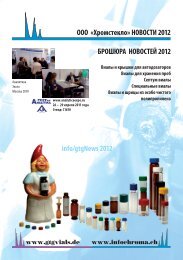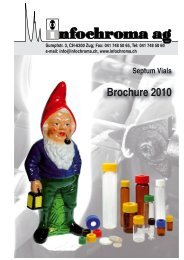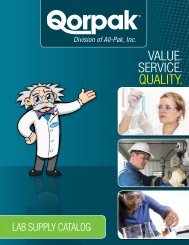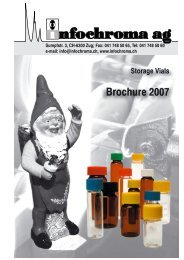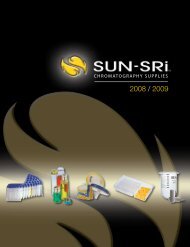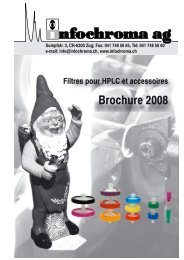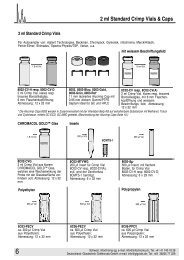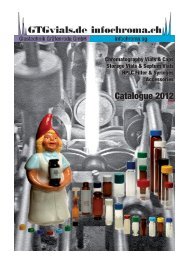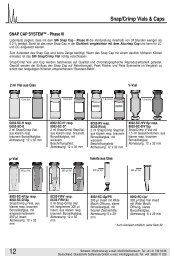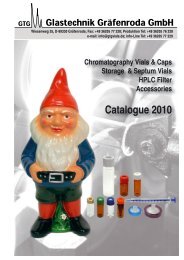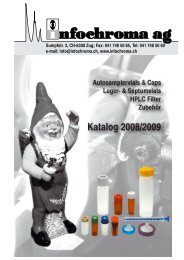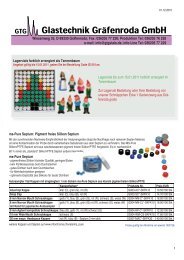Valco Fittings - infochroma ag
Valco Fittings - infochroma ag
Valco Fittings - infochroma ag
Create successful ePaper yourself
Turn your PDF publications into a flip-book with our unique Google optimized e-Paper software.
GENERAL REFERENCE<br />
Properties of Metals<br />
Stainless steel, Type 316<br />
This is the standard tubing material for chromatography,<br />
suitable for a wide variety of applications.<br />
It is cold drawn seamless, not welded, with close<br />
tolerances held on both ID and OD. We neither<br />
recommend nor offer Type 304 stainless steel for<br />
analytical applications.<br />
Austenitic stainless steels may be used for most<br />
chromatographic applications. Type 316 is most<br />
commonly used for HPLC because of its superior<br />
chloride ion resistance.<br />
Stainless steel, Type 303<br />
Recommended for GC use and general purpose<br />
connections, combining excellent machining<br />
characteristics with good resistance to corrosion<br />
and high temperature oxidation. Susceptible to<br />
attach by chlorides, iodides, and bromides.<br />
Stainless steel, gold-plated<br />
Improved inertness and high-integrity sealing for<br />
applications such as ultra pure gas analysis.<br />
Electroformed nickel (EFNI)<br />
We electroplate pure nickel over a diamond drawn<br />
mandrel in a continuous process, then carefully<br />
separate and remove the mandrel from the tubing.<br />
The result is an extremely inert and smooth interior<br />
surface (1–2 microinch finish). It is widely used for<br />
transfer lines, since it minimizes the potential for<br />
carryover or cross contamination often found with<br />
mill-drawn Nickel 200, due to its rough interior<br />
surface. Unlike glass- or silica-lined stainless, EFNI<br />
can easily accept tight bends and cutting without<br />
heating, and does not release dam<strong>ag</strong>ing glass<br />
fr<strong>ag</strong>ments or silica particles. Electroformed nickel<br />
has more in common with fused silica than drawn<br />
nickel tubing in terms of surface inertness and<br />
smoothness.<br />
Hastelloy C ® series<br />
This is the material most often recommended for<br />
corrosion resistance – it works when nothing else<br />
will. This versatile nickel-chromium molybdenum<br />
alloy has excellent resistance to most acids,<br />
including strong oxidizers such as ferric and<br />
cupric chlorides; nitric, formic and acetic acids;<br />
wet chlorine; sea water and brine solutions; and<br />
mixtures containing nitric acid or oxidizing acids<br />
with chloride ions. VICI uses only HC-22 for fittings<br />
and valve stators, rather than the older and less<br />
corrosion resistant HC-276.<br />
The best choice for most special applications<br />
where HPLC grade stainless cannot be used,<br />
Hastelloy C has excellent resistance to pitting, stress<br />
corrosion cracking, and oxidizing atmospheres up<br />
to temperatures well beyond any other standard<br />
components of the chromatographic system.<br />
Inconel 600<br />
One of the few metals which can be used with hot,<br />
strong solutions of m<strong>ag</strong>nesium chloride. Good for<br />
most severely corrosive environments at elevated<br />
temperatures. Resistant to sulfuric and hydrofluoric<br />
acid, and to all concentrations of phosphoric acid at<br />
room temperature. Poor resistance to nitric acid.<br />
Monel 400<br />
High resistance to hydrochloric, hydrofluoric, and<br />
sulfuric acid under reducing conditions. Attacked<br />
by oxidizing acid salts and hypochlorites. High<br />
resistance to chlorinated solvents and nearly all<br />
alkalis.<br />
Nickel 200<br />
Excellent resistance to caustics, high temperature<br />
halogens and hydrogen halides, and salts other<br />
than oxidizing halides. Good resistance to<br />
caustic soda and other alkalis except ammonium<br />
hydroxide.<br />
The industry standard nickel alloy tubing,<br />
containing trace amounts of copper, carbon,<br />
silicon, and other elements which impart certain<br />
mechanical characteristics. Like our 316 stainless,<br />
this tubing is cold drawn to close ID and OD<br />
specifications, and is suitable for many applications<br />
where a relatively inert and low cost nickel is<br />
required. While more inert than 316 SS in most<br />
applications, it is still absorptive and has a relatively<br />
rough interior. Use electroformed nickel tubing for<br />
applications requiring a high level of inertness or<br />
finish.<br />
Nitronic 50<br />
Good resistance to chlorides, sulfuric acid, and sea<br />
water. Resistant to sulfur gases such as hydrogen<br />
sulfide and sulfur dioxide.<br />
Nitronic 60<br />
Chemical resistance is similar to Type 316 stainless,<br />
but its resistance to galling and oxidation make<br />
it superior to Type 316 or 303 in the majority of<br />
applications. This is the standard material in<br />
<strong>Valco</strong> and Cheminert metal valve lines.<br />
254 | VICI AG International Sales: + 41–41–925–6200 Fax: + 41–41–925–6201 | www.vici.com



